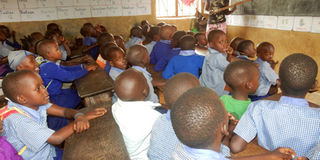Prime
Integrate culture in teaching

Educationists emphasise the need for using items and the environment that students are familiar with when teaching. Photo by Felix Warom Okello/Bill Oketch
What you need to know:
The discussion about the effectiveness of the Ugandan education system in creating people who are actively involved, interested and with knowledge about who they are – culturally, their immediate society and environment is still ongoing.
Stephen Mugarura, an education student at Makerere University, recalls that in his secondary school he studied about the Canadian Prairies, Tennesse Valley Authority, but does not see how these are likely to help him in his life currently or after school.
“They might have enriched our knowledge, but they have so far practically not helped me all my life. Sometimes I sit back and wonder why students today have to learn the same things, other than issues within their reach, and context,” he says.
But Mugarura is not the only person with such concerns. On July, 27 educationists, researchers, policy makers, and the media convened at Shangai Restaurant to rethink about the person they are creating through the Ugandan education system.
“I know a nine-year-old pupil who was asked by their teacher to give one example of a type of food and the child mentioned guava. It was marked wrong. At the next teacher-parent academic meeting, the child’s anxious mother brought up the matter only to be told by the teacher that her daughter had been told that guava is a fruit, not food,” Dr Connie Nshemereirwe, an educator and researcher, says during the launch of a paper - Creating a thinking person: The need for higher order skills in the Ugandan Education system by Kigo Thinkers, a public policy think tank.
Irrelevant teaching materials
Take teaching materials for example; you have a child reading a story about peach trees, meadows, cabin cruisers, and towns such as New York – things and images that do not make sense or directly relate to them. “Can’t we have reading materials that directly interact with students? Stories talking about digging in the garden, about Owino market, and how it is like to board a taxi, and to sit in Kampala traffic jam, events related to our daily life as Ugandans,” Prossy Namayanja, a parent wonders.
There is a big gap between the teacher and the learner. The teacher is often looked at as all knowing, and the only holder of correct information with powers to determine what is wrong and right.
We have all passed through the same system and the biggest challenge there is, most parents want their children to go through the same system that they went through, says Remegious Baale, a senior curriculum specialist at National Curriculum Development Centre, says. “However, a better curriculum means more money but we have tried to do our part. At NCDC we drafted a new curriculum that puts into consideration some of those issues but it is still awaiting approval,” he continues.
Step in the right direction
“More African novels are being used on the syllabus, so students can be able to read about things they are familiar with. Novels and plays such as Cry the beloved country, House Boy, Black Mamba, Redemption are written in settings, themes language learners can identify with,” Faridah Namusoke, a teacher of literature at Kennedy High School, Kawuku says.
When teaching lower classes, local examples and often the local language is used so that pupils can relate. “For example; if I am teaching about animals domestic or wild, I usually use their local names and translate them into English, so that my pupils understand. Furthermore, we study the history of our people, the Baganda, Luo, Nilotics and more, which gives the children a background of where they come from,” Enid Hauha, a teacher at Right Care Primary School, Ndejje says.
Bridge the gap
There is a big gap between the teacher and the learner. The teacher often looked at as all knowing, and the only holder of correct information with powers to determine what is wrong and right.
Emphasise mother tongue
Earlier in 2016, the assistant commissioner for primary education, Dr Tony Mukasa Lusambu, warned schools against resisting teaching in local languages in early years of schooling arguing that the use of English as a method of instruction perpetuates passive learning. “When learners start school in (English), a language that is still new to them, it makes learning teacher-centered and reinforces passiveness and silence in classrooms, which in turn suppresses young learners’ potential and liberty to express themselves freely,” Lusambu said. “Teaching a child in their mother tongue is very important. Even in English, the person has to first internalise something in their local language and then air it out in English,” he argued.



